HTC One S Review - International and T-Mobile
by Brian Klug on July 17, 2012 9:30 AM ESTThe HTC One S has an internal 1650 mAh 3.7V nominal battery, which works out to a capacity of 6.1 Whr. That’s smaller than the 6.66 Whr battery (1800 mAh, 3.7V) in the HTC One X / XL, but still pretty big for a phone of this size and thickness. The question then becomes what battery life is like on the One S, and to test I turned to our current smartphone battery life tests which I’ve described before. The web browsing tests consist of a few dozen pages which are loaded every 10 seconds with the display set at precisely 200 nits (using a meter) until the phone dies - this is done over WiFi and cellular data. The tethering test consists of a single client notebook attached to the device using its onboard WiFi hotspot function, and four tabs of our page load test alongside a 128 kbps streaming MP3 station are loaded on that notebook until the phone dies.
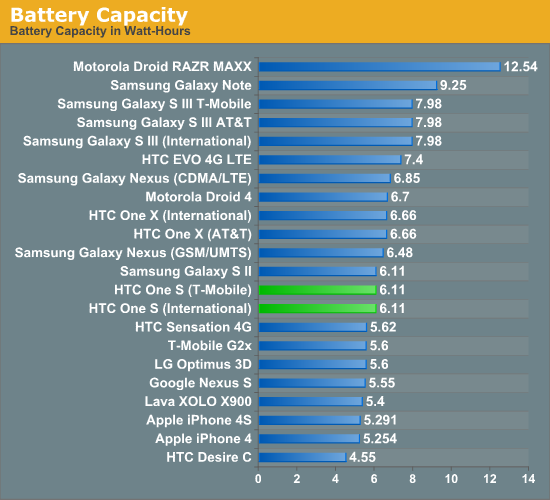
I should also note that the One S T-Mobile and International results differ somewhat because of the difference in air interface - the T-Mobile variant is on that network’s DC-HSPA+, whereas the One S International I had to test on AT&T in an 850 MHz market (Pinal county) where AT&T holds an 850 MHz license just north of me. Where I live, AT&T is only PCS 1900 MHz.
Remember that DC-HSPA+ is aggregating together two 5 MHz wide WCDMA carriers on the downlink which in theory should require more power from the power amplifiers per unit time. The age old question, however, is whether the increase in throughput can result in the system both achieving a higher data/time rate, and suspending quicker, thus saving some power. Some of the One S International results are also absent because of my limited time in 850 MHz AT&T markets.
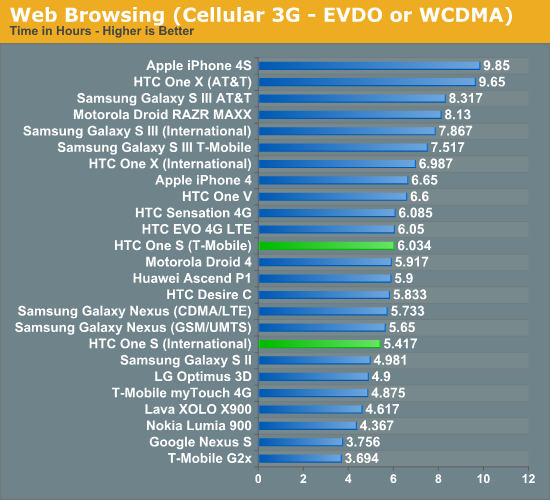
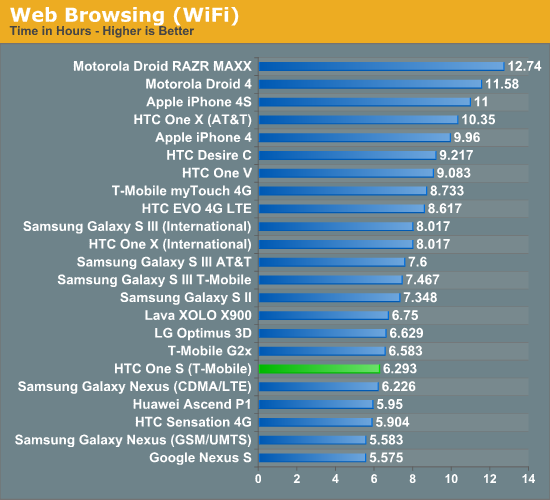
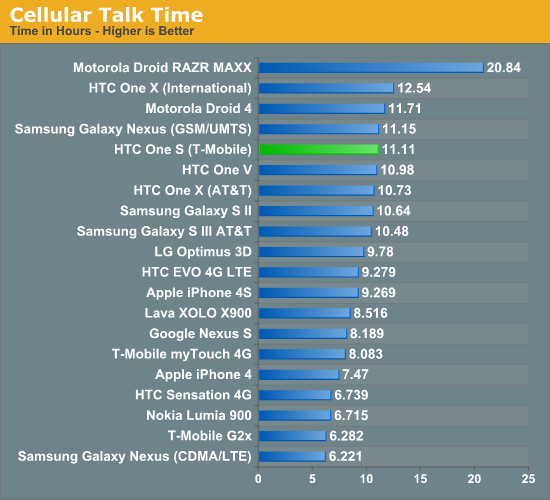
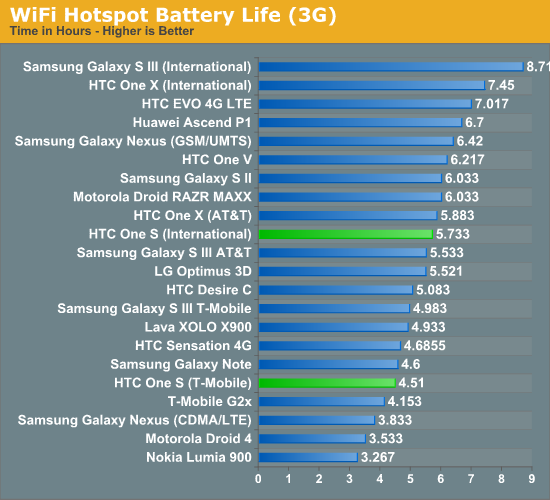
I’ve had requests to measure charge time on smartphones, and thankfully the One S makes this possible with the charging status LED. I measured 1.533 hours required to charge the One S from completely empty to full using the supplied charger; this is a pretty speedy charge time compared to some of the other devices I’ve reviewed as of late. I’ll spare everyone the usual rant about USB charging spec and using the right charger that implements the appropriate data pin impedance.
While the One S has basically the same 28nm dual core Krait SoC as the One X (MSM8960 and MSM8260A differ in baseband), the One S also has to deal with a relatively power hungry SAMOLED display. We’ve shown before that this combination suffers in our battery life test especially because our test pages all have white backgrounds.
In day to day use with the One S on auto brightness, I have to say that I’ve never been want for more battery life at all. If you look at the web browsing test, the One S is just a half hour short of the iPhone 4 result. I’d say that’s pretty impressive. If you’re on a One S (or any AMOLED phone) and trying to eek some more longevity out of the device, as always my suggestion is to lower display brightness and set a black background on the home screen, which is what I do with all my AMOLED phones.










97 Comments
View All Comments
ltcommanderdata - Tuesday, July 17, 2012 - link
To go with the smallest screen size for a modern smartphone, the iPhone 4S also has the smallest battery as shown on the first chart on page 2. It'd be interesting o find out how display power consumption scales with screen size to see if they are scaling battery size fast enough to fully compensate, but big phones with big screens do tend to have big batteries so big screens shouldn't automatically mean bad battery life.Penti - Tuesday, July 17, 2012 - link
4S doesn't have HSPA+ baseband only 14.0 Cat 10 HSDPA. I.e. 14Mbit "4G-branding". In short small batteries, large screens, fast processors and gpus and power hungry baseband is what drains these devices. You need a significant larger battery to have a better battery life here. For most devices that isn't a priority. For example the iPad 3 gen has a larger battery then MBAir 11.amdwilliam1985 - Tuesday, July 17, 2012 - link
Please explain the 4G part to a friend of mine.She claims her 4G iPhone 4s with iOS 5.1.1 on AT&T network can't go through a day with moderate usage.
Penti - Tuesday, July 17, 2012 - link
What, it's just a 3G WCDMA baseband, no other radio or tech it shouldn't draw more power just because the icon says 4G in this 3.75G device. No smartphone survives more then a day with moderate usage, calls and what not. An 4s is spec'd at 8 hours talk time and 6 hours of internet use over 3G respectively. Play a game and the device is pretty much dead half day. Using apps that pull data over the wireless cellular network, talk for a few hours and play a game for 15 minutes and it should be pretty drained. If there is nothing wrong with the device then it is the usage that has to change to accommodate more battery life. If you need to talk for hours a day and be connected to chat, surf the web, use apps that leverage the internet and all that over the network you would need some solution to charge the phone over the day not matter what device you run.Why some people whine about early LTE phones is because they had bad dual baseband chips and about half the talk time. Pretty bad battery life surfing on LTE etc.
Spoelie - Tuesday, July 17, 2012 - link
I'm wondering if the battery tests have ever been redone following iOS updates. In my experience, the battery life gets progressively worse with every new update. In this case, doing the tests once on release day and reusing the numbers for months on end may not be the best approach.Anand Lal Shimpi - Tuesday, July 17, 2012 - link
I'll take the blame for this one. Notice the revamp of our tablet and OS X battery life tests? The smartphone web browsing test is in need of an update there as well. iOS has gotten a little too "good" at what we're doing there, at least in the web browsing test. The call and tethering tests are still great cross-platform indications of battery life.rd_nest - Tuesday, July 17, 2012 - link
I think we should also look at multimedia playback times. Run high profile video files to check battery rundown time. It's an important parameter as far mobile usage is concerned.The SGS3 (International) is getting pretty good numbers compared to US SGS3 models.
yvizel - Tuesday, July 17, 2012 - link
Saying 3.5'' vs. 4.3'' is not an accurate argument.If you come to think of it, the iphone is a smaller device, therefore packs a smaller battery (as you can see in the Battery Capacity chart).
Also, I would rather have a "slower" processor and more battery juice than have an octa-core @ 4GHz on a smartphone with 1 hour of usage!
Not all of us use smartphone for gaming or whatever. I guess that the more common usage is web, email, GPS and other basic stuff. So again, no need for zillion cores on a smartphone.
Oh, and great review! looks like a great device!
Connoisseur - Tuesday, July 17, 2012 - link
My point is that it's extremely difficult to compare phones of different size, resolution, screen type, OS and capacity. Even if you remove the OS out of the mix (so you can compare OS "efficiency"), the only comparison you can really make between two different devices is hours/battery capacity efficiency.At least when comparing laptops, you have some basis for comparison (comparable hardware or form factor for example).
amdwilliam1985 - Tuesday, July 17, 2012 - link
We can do the following 2 tests.1) Hack and put iOS on an Android device and run the same test against iPhone 4s.
2) Hack both device and put a custom OS on both and run the test.
This way we can see if it's software or hardware that's affecting the battery life.